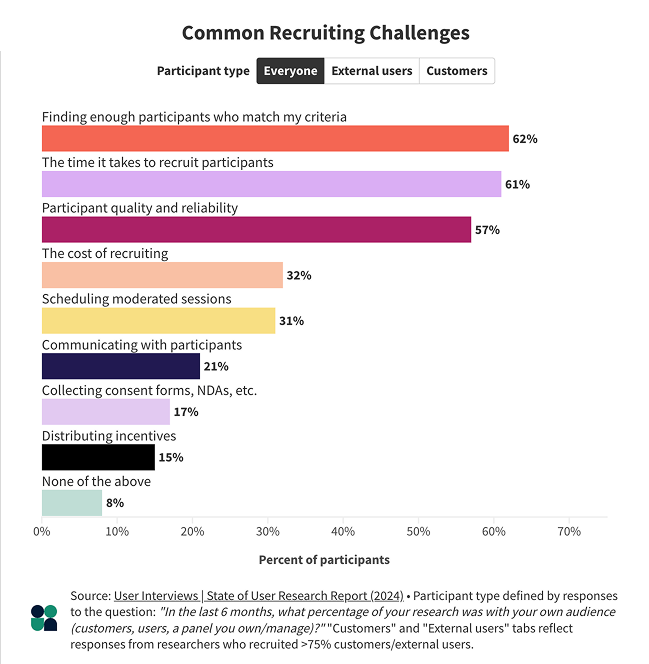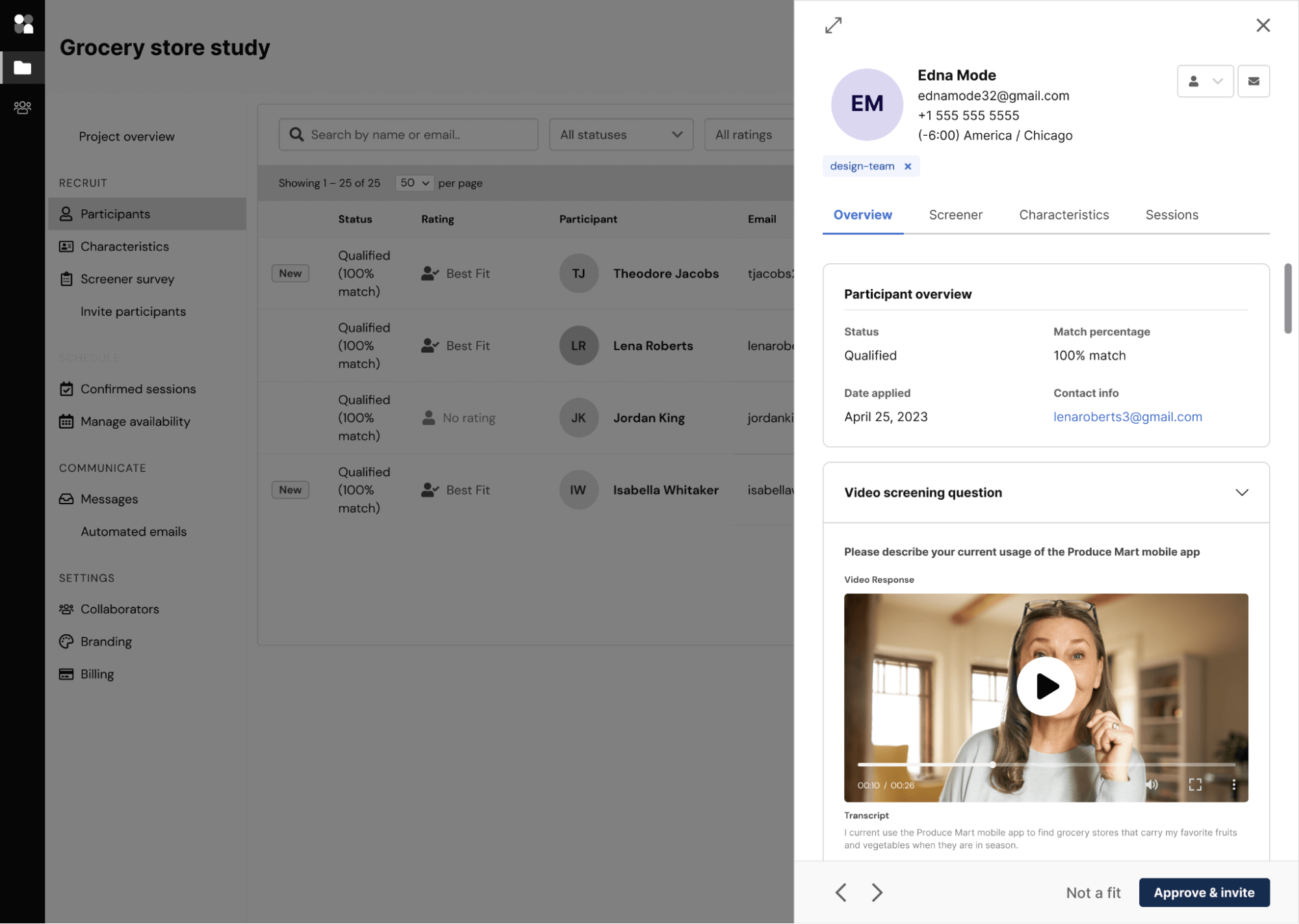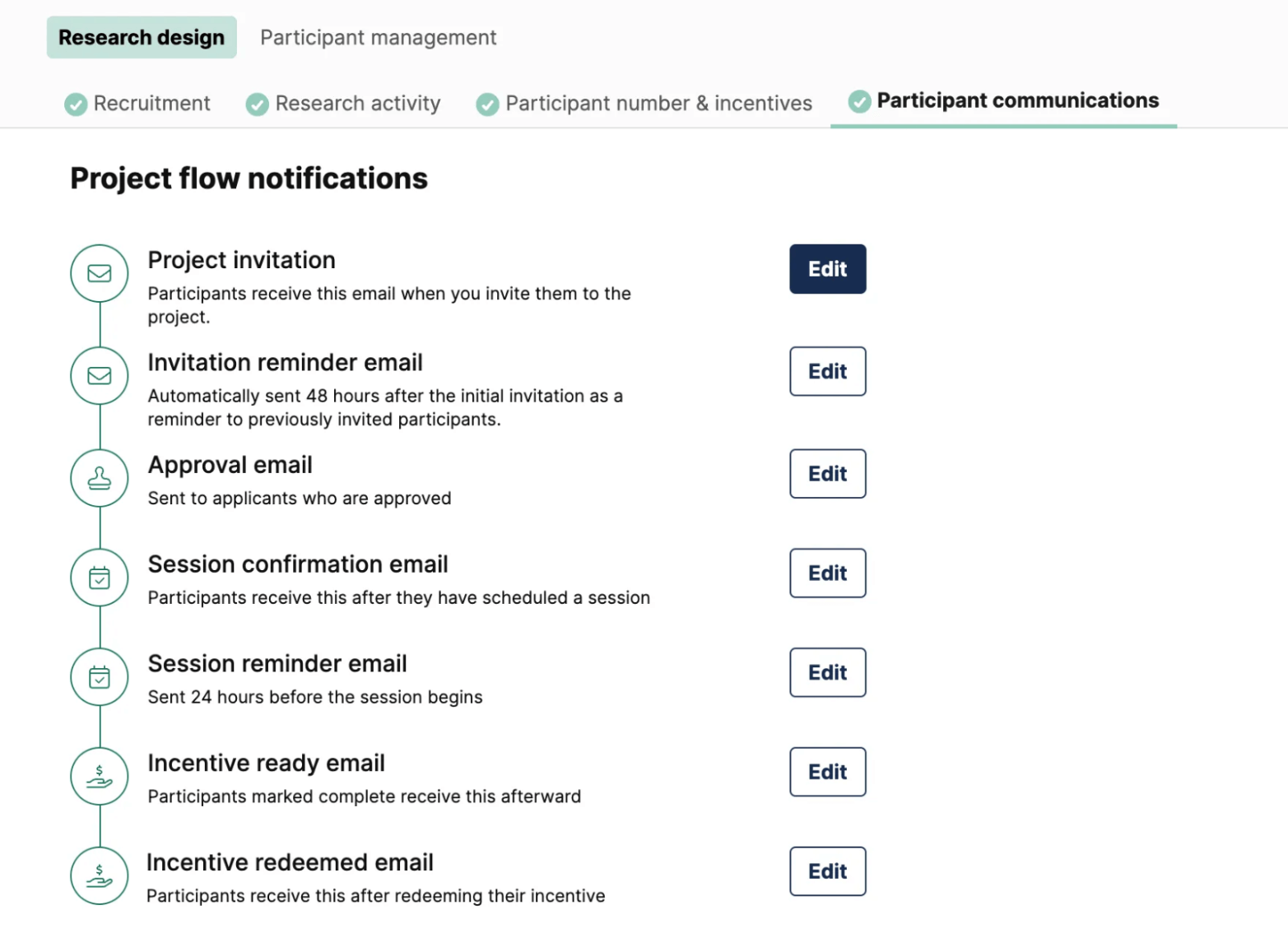Having unqualified or low-quality respondents slip into user research, surveys, and other studies is a common challenge, especially in large-scale research projects. In fact, our 2024 State of User Research report found that the number one recruiting challenge was finding enough participants that match the criteria (62% of respondents), and number three was participant quality and reliability (57%).
A single poor-fit participant getting approved for your research is an annoyance, but it can easily be brushed off as part of the process. However, consistently attracting respondents who don’t meet your criteria is a clear sign that your recruitment process isn't working.
Common mistakes that lead to this include:
- Unclear participant criteria: Failing to define specific demographics, behaviors, or expertise needed for your study.
- Over-reliance on broad channels: Using platforms like social media without thorough vetting tools to filter for quality.
- Skipping verification steps: Not checking respondents’ past engagement or feedback, leading to unreliable participants.
In our experience of building a database of 6 million qualified panelists, sourcing high-quality respondents requires a strategic, intentional process to ensure you’re only engaging participants who align perfectly with your study’s specific criteria.
However, before you can build an effective recruitment plan, you must understand what separates a high-quality respondent—someone who meets your demographic, behavioral, or attitudinal requirements and delivers actionable insights—from a low-quality one.
Below, we'll thoroughly explain the key differences between high- and low-quality respondents and then guide you through our five-step process for sourcing high-quality respondents. We’ll also include real-life examples from the User Interviews platform.
Recruit high-quality respondents for your research in hours. Book a demo to find out more.
What makes a respondent high-quality?
A high-quality respondent is someone who’s reliable, relevant, and engaged. This allows them to deliver perspectives that directly inform and elevate your research outcomes.
Specifically, they must meet four rigorous criteria:
- They represent themselves honestly and accurately: They provide truthful demographic, behavioral, and attitudinal data that match your study needs. Participants who lie about their experiences or qualifications will compromise the validity of your research.
- They precisely match your audience criteria: They align with specific demographic or psychographic profiles, like urban professionals or early tech adopters. Without deep targeting that allows you to define exactly who your perfect participant is, you can recruit the wrong people and dilute your study’s relevance.
- They demonstrate professionalism by arriving prepared and on time: They attend sessions on time and ready, or proactively reschedule with clear communication. Unreliable participation disrupts schedules and data quality, costing you time or money because you need to go back and recruit additional participants.
- They are both willing and able to articulate valid, usable information: They offer detailed, context-rich feedback that drives actionable outcomes. Vague, off-topic, or low-effort responses fail to advance research goals and only provide surface-level insights.
Manually identifying and verifying qualified participants is extremely complex and challenging.

That’s why using a research recruiting platform like User Interviews tends to provide the best results.
Their panel verifies participant social media accounts, offers rich profile data, automatically tracks participant behavior, and uses dedicated channels to find research participants.
Find out more in the User Interviews Research Panel Reports.
5 steps to source high-quality respondents
Knowing exactly who you need—specific demographics, behaviors, or expertise—increases your chances of attracting the right people. Here are five steps to source high-quality respondents who deliver quality insights.
1. Choose a fast, reputable online research panel
If you want to avoid unqualified respondents and be as efficient as possible, you need trustworthy, purpose-built recruitment channels. Manual recruitment typically relies on various DIY tools (e.g., social media, spreadsheets, etc.) to source, schedule, and survey respondents.
This approach is slow and unreliable, and there is no way for you to confirm respondent quality without significant time and effort. You’re more likely to attract fraudulent participants who misrepresent qualifications and provide inaccurate or low-quality responses.
Alternatively, you could opt for recruiting agencies that offer extremely precise targeting. The problem is that they are extremely slow to produce results, and the price per respondent is significantly higher than that of other panels. Meanwhile, all-in-one online survey platforms offer convenience but have limited, low-quality participant pools that fail to meet specific criteria.
User Interviews helps you avoid all these problems with its direct access to a proprietary panel of over 6 million high-quality participants, rigorously vetted for reliability and relevance.

Unlike platforms that rely on third-party sourcing, User Interviews handles recruitment directly, maintaining fraud rates below 0.3% through a matching model trained on over 20 million unique data points.
Participants can provide rich profile data, including social media verification links (e.g., LinkedIn URLs) and additional qualification steps, giving you confidence in who’s joining your study. User Interviews also ensure participants don't game the system by using duplicate emails or multiple accounts.

Additionally, the system tracks unreliable respondents. Anybody who does not show up to a scheduled session gets flagged. The same is true for respondents who lie in their profiles or exhibit any negative behavior (such as being rude, hostile, or inappropriate) to researchers or other study participants.
Not only does User Interviews rigorously monitor participant quality, but the platform also enables researchers to maintain participant quality. After a session is completed, you can leave participant feedback ratings that let you flag poor performers, triggering internal reviews to limit their future participation.
The automated system also highlights copy-pasted screener responses to researchers (which may signal AI use), while predictive data models proactively remove participants matching fraudulent patterns.

These features are in place to ensure the panel is comprised of high-quality respondents, allowing you to focus on your research rather than worrying about whether your respondents are qualified.
2. Set precise targeting criteria
Precise targeting ensures that respondents accurately represent your target audience, delivering more relevant and unbiased insights critical for high-quality market research. Poorly targeted participants, even if engaged, provide survey data that doesn't align with your study’s goals, undermining overall outcomes and credibility.
User Interviews simplifies targeting by letting you define respondents with specific demographic attributes (e.g., age range, income level), professional characteristics (e.g., job titles, industry experience), and technical details (e.g., iOS or Android users).

The advanced matching algorithm analyzes behaviors, job roles, or locations (e.g., specific cities in the US or UK) to deliver respondents with high accuracy, reducing manual effort.
Key targeting criteria to use include:
- Psychographics: Focus on respondents’ interests, hobbies, opinions, or lifestyle choices to understand their motivations and align with the context of your study.
- Behaviors: Target specific actions, such as “shops online weekly” or “uses public transit daily,” to ensure participants’ habits match your research needs.
- Demographics: Define age, gender, education, income, or marital status to create a sample that accurately represents your target audience.
- Geographics: Specify locations, such as a country, city, or a radius around a region, to ensure geographic relevance for location-based studies.
Many alternative recruitment platforms don't offer this level of advanced targeting, making it hard to find specific profiles or verify their authenticity. User Interviews allows you to set your target demographic and attract more qualified participants, leading to higher quality research results.
3. Use screener surveys to filter low-quality respondents
Screener surveys are how you’ll differentiate a high-quality respondent from a low-quality one. These short, targeted questionnaires act as your safeguard to ensure you let through only participants who align with your study’s goals.
Through an analysis of more than 42,000 screeners, these best practices have emerged to increase completion rates and identify more suitable potential respondents.
- Don’t give away too much: Avoid revealing your study’s purpose or company name upfront to prevent participants from tailoring survey responses to qualify. Use neutral questions, like “Which streaming services do you pay for?” instead of naming your target service. For professional studies, include specific questions about experience or proficiencies to verify fit.
- Avoid too many yes/no answers: Binary questions, like “Do you own an iPhone?” are easy for dishonest participants to guess. Rephrase them as multiple-choice questions, such as “What smartphone do you use?” to gather detailed, reliable data and reduce the risk of fraudulent responses.
- Get to know your candidates: Include a short-answer question, like “What’s your favorite social media app and why?” to gauge a participant’s expressiveness and engagement. Descriptive responses reveal who can provide thoughtful feedback during interviews, distinguishing high-quality respondents from those who offer low-effort responses.
- Use skip logic: Apply skip logic to tailor the survey flow, directing respondents to relevant questions or disqualifying them based on answers. For example, if you ask “What smartphone do you use?” then only iPhone users will proceed to questions about iOS versions.
User Interviews’ drag-and-drop tool makes it easy to build effective custom screeners. You can quickly create surveys from scratch, choosing from question types like pick-one, multi-select, short-answer, long-answer, or video-response to match your study’s needs.

When creating new questions, you can bulk paste answers to create screeners quickly. This is especially helpful for multiple-choice question options (pick-one, multi-select, etc.).
Once you finish building a screener, you have the option to save it as a template, allowing you to reuse it later without having to start from scratch.
If you want extra assurance that you’re speaking to high-quality respondents or need to screen for attributes that can’t be conveyed through a survey, consider double-screening. This premium add-on allows you to verify screener-qualified participants before approving them.

You can contact candidates via email or phone to confirm details, check their availability, match their info against an existing database, or prompt them to submit a 90-second video response to a custom question.
This extra layer of screening finds discrepancies, verifies expertise, and identifies articulate respondents, significantly reducing the risk of low-quality participants slipping through.
4. Attract candidates with reasonable incentives
Finding high-quality respondents is difficult when research incentives are too low or you take too long to distribute them after the study is completed. Low incentives tend to attract low-effort applicants, such as professional survey-takers who provide generic answers, thereby diluting the quality of your research.
To source genuinely invested participants in your study, you need competitive incentives that respect their time and effort. Not only that, but you have to pay your participants quickly.
What's the right incentive for your research? Try our data-backed research incentive calculator.
With User Interviews, incentivizing participants is seamless and designed to attract the most qualified respondents. The platform lets you set up and process rewards entirely within the system, eliminating the need for external payment tools.

You can choose from over 1,000 incentive types in AUD, CAD, GBP, EUR, or USD, including Amazon gift cards, cash rewards, or donations, available across more than 200 countries. Once a session is complete, incentives are sent instantly, keeping participants happy and engaged.
If you prefer doing it yourself, you can set up manual payments and still take advantage of other User Interviews' features. Plus, you can adjust incentive amounts on the fly, even after the project launches, to draw in more qualified respondents. This allows you to see what works (and what doesn't) and adjust accordingly.
5. Engage and schedule participants to avoid no-shows
Even when you find respondents who perfectly match your study’s criteria, getting them to actually show up is another hurdle in ensuring their quality. A respondent might check all the boxes—right demographics, behaviors, and engagement—but if they miss their session, their value to your research drops to zero.
No-shows disrupt your schedule, waste resources, and force you to scramble for replacements. Manual scheduling exacerbates this challenge, requiring you to juggle calendars, send individual confirmations, and follow up with participants for responses. This often leads to errors, such as overlooked conflicts or forgotten reminders, which increases the likelihood of a no-show.
With User Interviews, scheduling is streamlined to keep respondents engaged and ensure they show up. The automated scheduling tool syncs with your Google or Outlook calendar, letting you set availability and preferences like session dates, buffer times, or daily session caps.
Once set, the platform books sessions without conflicts, sending meeting links automatically.

Participants choose from available time slots that fit your rules, cutting out back-and-forth.
For studies that require the whole research team’s participation, you can assign moderators or required attendees, and the system coordinates everyone’s calendars seamlessly.
To reduce no-shows and increase response rates, User Interviews sends automated reminders and offers easy rescheduling—participants can adjust slots directly, or you can manage changes from the “Confirmed sessions” page.
While you likely won't hit a 0% no-show rate even with perfect scheduling, you can try to engage respondents to lower the chances of participants missing a session. Ideally, try to set up a regular outreach cadence like this:
- Contact them at sign-up
- Contact them again a week out (7 days before the interview if they scheduled more than a week before)
- Contact them the day before
- Contact them a few hours before the session with details like access info or a researcher’s phone number for real-time help

User Interviews allows you to set up and automatically send these outreach emails.
Attract quality respondents for your research studies
The success of your research heavily relies on the quality of your participants, making a strategic recruitment approach essential from the start. Our five-step process provides a proven framework to source reliable, relevant respondents who deliver actionable insights.
User Interviews makes recruiting top-tier respondents with minimal hassle. The platform offers access to over 6 million vetted participants, advanced targeting, customizable screeners, flexible incentives, and automated scheduling, ensuring you get top-tier respondents with minimal hassle.
Ready to elevate your research with better participants? Book a demo with User Interviews today.



















